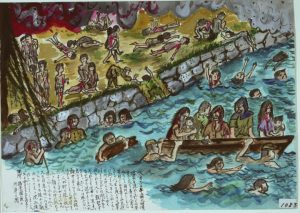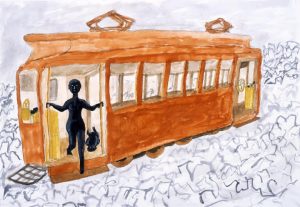Nihon Hidankyo awarded Nobel Peace Prize: Peace Memorial Museum to provide digital data of 13 “A-bomb drawings” to Oslo for exhibit related to award
Nov. 27, 2024
by Keiichi Nobira, Staff Writer
On October 26, the Hiroshima Peace Memorial Museum (located in the city’s Naka Ward) announced it would provide the digital data of 13 “A-bomb drawings” created by A-bomb survivors for a related exhibition that will begin in Oslo, Norway, in conjunction with the awarding next month of the Nobel Peace Prize to the Japan Confederation of A- and H-Bomb Sufferers Organizations (Nihon Hidankyo). The exhibition will communicate the tragedy of 79 years ago that has been etched into the memories of survivors.
The Nobel Peace Center, the exhibition’s organizer, selected the images for display from among around the 2,000 stored in the museum’s database. The images depict scenes that have served as the origins of the A-bomb survivors’ movement dedicated to the abolition of nuclear weapons, including one of soldiers and nurses drenched in blood at the Hiroshima First Army Hospital (located in the present-day area of Motomachi in the city’s Naka Ward), people immersing themselves into a river to escape fierce flames, the charred bodies of a mother who remained in a standing position at the exit door of a streetcar and her child, as well as countless corpses floating on the surface of a river.
The Peace Center will print in color the digital data on postcard-size paper (10 centimeters in length, 15 cm in width) to allow visitors to pick up and touch the images. The Center says it came up with the method of display based on its aim of having visitors come into closer contact with the event at that time and to elicit ever more empathy. The exhibition period is scheduled to be around one year, from December 11, the day after the Nobel Peace Prize award ceremony, until the middle of November 2025.
The Peace Memorial Museum will consider leasing actual items from its collection, including artifacts of A-bomb survivors, if the Center makes any additional requests. According to the museum, “The exhibition is a good opportunity to convey the reality of the atomic bombing to the international community, and we hope visitors look carefully at the materials.”
(Originally published on November 27, 2024)
On October 26, the Hiroshima Peace Memorial Museum (located in the city’s Naka Ward) announced it would provide the digital data of 13 “A-bomb drawings” created by A-bomb survivors for a related exhibition that will begin in Oslo, Norway, in conjunction with the awarding next month of the Nobel Peace Prize to the Japan Confederation of A- and H-Bomb Sufferers Organizations (Nihon Hidankyo). The exhibition will communicate the tragedy of 79 years ago that has been etched into the memories of survivors.
The Nobel Peace Center, the exhibition’s organizer, selected the images for display from among around the 2,000 stored in the museum’s database. The images depict scenes that have served as the origins of the A-bomb survivors’ movement dedicated to the abolition of nuclear weapons, including one of soldiers and nurses drenched in blood at the Hiroshima First Army Hospital (located in the present-day area of Motomachi in the city’s Naka Ward), people immersing themselves into a river to escape fierce flames, the charred bodies of a mother who remained in a standing position at the exit door of a streetcar and her child, as well as countless corpses floating on the surface of a river.
The Peace Center will print in color the digital data on postcard-size paper (10 centimeters in length, 15 cm in width) to allow visitors to pick up and touch the images. The Center says it came up with the method of display based on its aim of having visitors come into closer contact with the event at that time and to elicit ever more empathy. The exhibition period is scheduled to be around one year, from December 11, the day after the Nobel Peace Prize award ceremony, until the middle of November 2025.
The Peace Memorial Museum will consider leasing actual items from its collection, including artifacts of A-bomb survivors, if the Center makes any additional requests. According to the museum, “The exhibition is a good opportunity to convey the reality of the atomic bombing to the international community, and we hope visitors look carefully at the materials.”
(Originally published on November 27, 2024)









